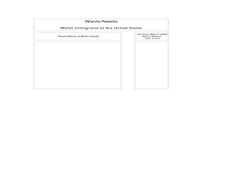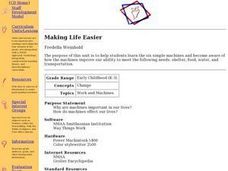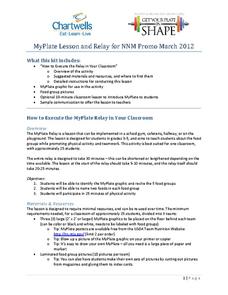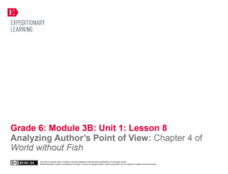Texas Education Agency (TEA)
Build a Paper Structure
Who knew that paper is an amazing building material? Scholars learn about the properties of planar materials, such as paper, as well as their structural capabilities in the sixth lesson a series of 11 on architecture. Working in groups,...
Curated OER
Traits Needed for Effective Group Process
Students compile a list of 10 desirable traits for working with others. They evaluate the traits that are necessary for specific jobs and describe them in work settings.
Curated OER
Grade Cards
Students examine a school grade card. In this reading lesson, students discuss the school grade card in order to understand how their child is doing in school. Students discuss the symbols and terminology used on the grade cards.
Curated OER
Second Grade - Math
For this mixed second grade math review worksheet, 2nd graders answer 25 multiple choice questions. They work with patterns, place value models, fractions, and money in this 8 page worksheet set.
Curated OER
Push/Pull Factors and Welsh Emigration
Students view and discuss short sections of movies that relate to immigration. Working in groups, students create a map that shows directions of internal migration in their assigned geographical area. Students review ads/booklets created...
Curated OER
Contributions - Grade 3
Third graders research and report on the contributions of the First Nations. In this First Nations contribution lesson, 3rd graders read and discuss books about the Metis, Inuit and other First Nations. They compare and contrast the...
Alabama Learning Exchange
Systems Every "Body" Needs to Know
Through an informative WebQuest and group work, learners explore the human body and cell structure. They create a cell diagram, research a disease, write a letter explaining the causes of human disease, and work in small groups to create...
Curated OER
Food Pyramid-Planning a Healthy Meal
Learners identify the five basic food groups. They use their knowledge of the food pyramid to plan a full meal that incorporates at least one serving of food from each group. Pupils classify their ingredients according to the food groups.
Curated OER
Scavenger Hunt
First graders participate in a scavenger hunt. In this grouping lesson, 1st graders search for pictures of objects around the room, then find the card with the name of that object written on it. Students also discuss the similiarities...
Curated OER
Making Life Easier
Students use a chart of the six simple machines and become aware of how the machines improve our ability to meet the following needs: shelter, food, water, and transportation. Students use model cars to experiment with force. They divide...
Curated OER
Healthy Eaters
Students classify foods as "healthy" or "unhealthy" and sort foods into appropriate food groups. For this nutrition/physical education lesson, students play a game in which throwing skills are practiced. Pictures of food are sorted into...
Curated OER
Complete or Incomplete? That is the Question!
Students work in small groups to determine factors that contribute to a well-done assignment. They report their findings to the rest of the class.
Curated OER
Risk Taking Behaviors
Tenth graders listen to a presenters introduction and write questions they hope to have answered during the presentation. They listen to a presentation and record notes. They participate in small group discussion and complete...
Tech Museum of Innovation
Tree House Escape
Use simple machines to escape from a tree house. Pupils learn about simple machines and how they are useful in everyday life in a STEM lesson. Groups then design a device to rescue a friend stuck in a tree house.
EngageNY
Researching Facts
How did the 1906 San Francisco earthquake and fire affect the city's inhabitants? Scholars embark on a quest to discover the answer as they work in small groups to research articles about the event. They finish by completing a jigsaw...
Cartwells
MyPlate Lesson and Relay
Youngsters are up and moving in an exciting relay race designed to help them better understand where common foods fall on the MyPlate nutritional guidelines. Working in teams, they identify images of foods and name what food groups...
EngageNY
Discussing and Identifying Themes: What Makes a Good Children’s Book?
Working in small groups, scholars look closely at a children's book to evaluate narrative techniques. Next, they complete a Children's Book Scavenger Hunt worksheet to analyze the literary elements of their selected stories.
Curated OER
6th Grade Art
Sixth graders create "macquette" sculptures, which would be models for larger playground pieces.
California Department of Education
How to Succeed in Life
Is it possible that six simple traits lead to a happy, successful life? Part four of a six-part series of college and career readiness lessons examines the effects of character in determining success. Working groups discuss...
EngageNY
Analyzing Author’s Point of View: Chapter 4 of World without Fish
Give me a clue. Scholars work in triads to use highlighters and mark clues that lead to the author's point of view in World without Fish. The Author’s Point of View graphic organizer helps them map out their thoughts.
EngageNY
The Painted Essay: Developing a Conclusion and Adding Linking Words
In conclusion ... this essay is the best! Scholars continue working on their painted essays by creating the conclusion. They work in groups to analyze the concluding paragraph in the model painted essay, The Electric Motor. After...
California Department of Education
Learning About Myself
After completing an interest survey, peers group together based on similar likes. They work collaboratively to create a poster that highlights their interests. Groups share their finished products with the class.
EngageNY
Close Reading: Paragraph 4 of “Refugee and Immigrant Children: A Comparison”
Why is reading a text closely a helpful skill? Using the 13th of 20 lessons from the Grade 8 ELA Module 1, Unit 2 series, scholars continue reading the informational text "Refugee and Immigrant Children: A Comparison." They work with...
Newseum
Putting the Consumer's Questions to Work
Who, what, when, where, why, and how are good questions to ask when evaluating a source. First, scholars find two sources of information relating to a chosen topic. Next, pupils complete a worksheet to gauge the source's credibility....

























